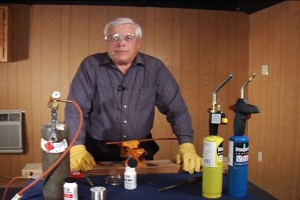The facility engineers knew they could not afford even a temporary interruption to the hospital's daily routine, which encompasses 27,000 patients in the acute-care facility each year.
Three Months' Planning ...
"We provide our patients with round-the-clock service," says Chuck Ayoub, St. Luke's manager of facilities engineering. "One of our key objectives for this expansion program is to have no interruption in the service to or comfort of our patients, physicians, and staff throughout the two-year length of construction."When building a state-of-the-art, 250,000-sq-ft, multistory medical facility, there are bound to be challenges. For St. Luke's, one challenge surfaced early. In preparation for the new structure, the underground chilled-water piping system, used to air condition the hospital, had to be excavated and rerouted, since it lay precisely where the new building would be built. The hospital receives chilled water from a central chilled-water plant, owned by Thermal Energy Cooperative, which serves the many hospitals in the downtown area known as the Texas Medical Center.
The construction work to reroute the chilled-water piping was going to require a 36-hr shutdown of the chilled water going to the hospital, scheduled for February 1999. Since it is not unusual for February temperatures to reach 80 degrees F in Houston, the hospital needed to maintain a satisfactory comfort level for its patients, physicians, and staff.
To find a solution, St. Luke's mechanical contractor turned to HVAC Portable Systems, Inc. (Houston) to set up 2,100 tons of temporary cooling during the 36-hr chilled-water system shutdown. The company's team began assessing the hospital's needs and coordinating its activities with all of the involved parties, including the hospital, general contractor, and mechanical contractor.
"We knew that with a hospital as large as St. Luke's in a densely populated area, there would be no margin for error," says David Swan, who handles the Carrier Corporation (Syracuse, NY) subsidiary's regional technical support. Swan reports that the planning began three months in advance of the shutdown to ensure a seamless transition and to minimize any overtime expenses for the customer.
...For 36 Hours' Performance
While a temporary chilled-water system with a 2,100-ton cooling capacity is normally accomplished using water-cooled chillers, the system set up for St. Luke's was designed to use 10 210-ton air-cooled chillers. The air-cooled chillers were selected due to the short time frame of the project and the necessity to set up and take down the system in a few days, allowing the ongoing construction to continue.HVAC Portable Systems designed a system consisting of air-cooled chillers, pumps, water distribution manifolds, hoses, fittings, electrical generators, electrical distribution panels, and cable. As the shutdown date neared and all of the plans were in place, HVAC's team of four project engineers and technicians sprang into action. As it would turn out, the entire project ran less than 10 days from setup to takedown.
The project began on a Monday, when a crane and 10 semi-tractor trailers full of equipment arrived on-site. For three days, workers made plumbing connections, set up 1,250-kW diesel generators, established all electrical connections, and checked over 3,500 ft of water hose for leaks.
In addition to testing along the way, Friday was scheduled as a testing day to start the generators and pretest all equipment on-site to ensure 100% operational system success. At one point during this phase, there was a generator failure, but thanks to planning and back-up generators, the system was back on-line in 30 minutes.
No Pause, Just Applause
At 8 a.m. on Saturday, the temporary system gradually took over the hospital's air conditioning system and held the system for a 2-hr final operational test. Based on this success, the company maintained the system without any problems for the next 36 hrs, while the piping contractor began his work of rerouting the existing chilled-water piping system.By Sunday evening, the hospital's main chilled-water system was back in operation and the temporary system was shut down. By the following Wednesday, the company and its caravan of semi-trailers were completely off-site, and the construction was back in full swing.
"When the whole job was completed, there was really only one way to measure whether or not we succeeded," Swan explains. "We asked St. Luke's if there were any complaints from the patients and employees who were in the hospital that weekend and learned there wasn't a single complaint."ES




